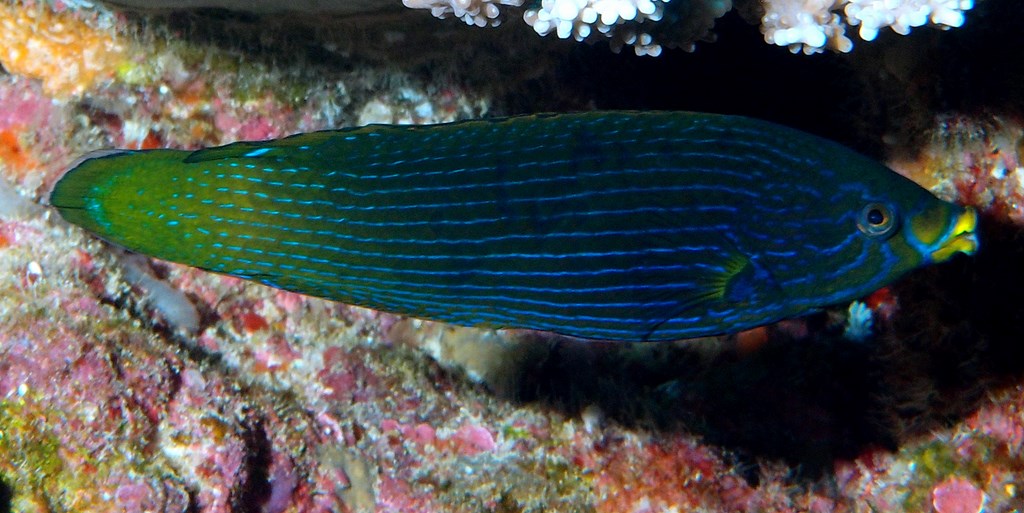LABRICHTHYS UNILINEATUS - (GUICHENOT, 1847)
Actinopterygii (Gigaclass) > Actinopteri (Class) > Teleostei (Subclass) > Perciformes (Order) > Labroidei (Suborder) > Labridae (Family) > Labrichthys (Genus)
Oneline wrasse, One-lined wrasse, Onelined wrasse, Tube-lip, Tube-mouth, Tube-mouth wrasse, Tubelip wrasse, Buis-lipvis, Kurobera, クロベラ, 半線黑隆鯛, 半线黑隆鲷,
Synonymes
Chaerojulis castaneus (Kner & Steindachner, 1867)
Cossyphus unilineatus (Guichenot, 1847)
Labrichthys cyanotaenia (Bleeker, 1854)
Labrichthys unilineata (Guichenot, 1847)
Labrichtys unilineatus (Guichenot, 1847)
Oneline wrasse, One-lined wrasse, Onelined wrasse, Tube-lip, Tube-mouth, Tube-mouth wrasse, Tubelip wrasse, Buis-lipvis, Kurobera, クロベラ, 半線黑隆鯛, 半线黑隆鲷,
Synonymes
Chaerojulis castaneus (Kner & Steindachner, 1867)
Cossyphus unilineatus (Guichenot, 1847)
Labrichthys cyanotaenia (Bleeker, 1854)
Labrichthys unilineata (Guichenot, 1847)
Labrichtys unilineatus (Guichenot, 1847)
Platyglossus ocellatus (Kner & Steindachner, 1867)
Thysanocheilus ornatus (Kner, 1865)
----------------------------------
Description
Dorsal spines (total): 9; Dorsal soft rays (total): 11-12 (usually: 11); Anal spines: 3; Anal soft rays: 10-11 (usually: 10); Pectoral fin rays: 14-15; Lateral line scales: 26; Gill rakers: 9-10. Body moderately slender, and compressed. Dorsal profile of head convex. Mouth small, terminal; Lips thick and fleshy, forming a short tube when mouth closed; Upper jaw with two pairs of incurved canines anteriorly, and a large canine posteriorly; Lower jaw with a pair of canines anteriorly, followed by 3-5 small teeth. Lateral line complete, angling sharply downward beneath posterior part of dorsal fin to straight peduncular portion. Head scaled, except for sheath over base of upper lip, preorbital, and chin. Caudal fin strongly rounded; Pelvic fins very long in males. Max. length: 17.5 cm TL. Depth range: 0 - 20 m.
Thysanocheilus ornatus (Kner, 1865)
----------------------------------
Description
Dorsal spines (total): 9; Dorsal soft rays (total): 11-12 (usually: 11); Anal spines: 3; Anal soft rays: 10-11 (usually: 10); Pectoral fin rays: 14-15; Lateral line scales: 26; Gill rakers: 9-10. Body moderately slender, and compressed. Dorsal profile of head convex. Mouth small, terminal; Lips thick and fleshy, forming a short tube when mouth closed; Upper jaw with two pairs of incurved canines anteriorly, and a large canine posteriorly; Lower jaw with a pair of canines anteriorly, followed by 3-5 small teeth. Lateral line complete, angling sharply downward beneath posterior part of dorsal fin to straight peduncular portion. Head scaled, except for sheath over base of upper lip, preorbital, and chin. Caudal fin strongly rounded; Pelvic fins very long in males. Max. length: 17.5 cm TL. Depth range: 0 - 20 m.
Color
Juveniles brown with two bluish white stripes on body, the lateral stripe disappearing with increase in size.
Female yellowish brown, stripes dull and faint.
Male color more intensified and bright than female color, a large yellow area beneath and above the pectoral fin base. Yellow lips thick and fleshy, forming a short tube when mouth is closed.
Etymology
Labrichthys: from Latin, Labrum = lip + from Greek, ichtys = fish.
unilineatus: from Latin prefix, uni- = one + from Latin, lineatus = line. Referring to single mid-lateral white stripe on juveniles.
Etymology
Labrichthys: from Latin, Labrum = lip + from Greek, ichtys = fish.
unilineatus: from Latin prefix, uni- = one + from Latin, lineatus = line. Referring to single mid-lateral white stripe on juveniles.
Original description: Cossyphus unilineatus Guichenot, 1847- Type locality: Guam, Mariana Islands, western Pacific.
Distribution
Indo-West Pacific: East Africa, Madagascar, Aldabra and western Mascarenes east to Society Islands, north to Japan, south to Western Australia, Lord Howe Island, New Caledonia and Tonga.
Biology
Inhabits shallow lagoon and semi-protected seaward reefs with high coral cover. Found near branching corals and feeds on its coral polyps, particularly staghorn Acropora.
Distribution
Indo-West Pacific: East Africa, Madagascar, Aldabra and western Mascarenes east to Society Islands, north to Japan, south to Western Australia, Lord Howe Island, New Caledonia and Tonga.
Biology
Inhabits shallow lagoon and semi-protected seaward reefs with high coral cover. Found near branching corals and feeds on its coral polyps, particularly staghorn Acropora.
